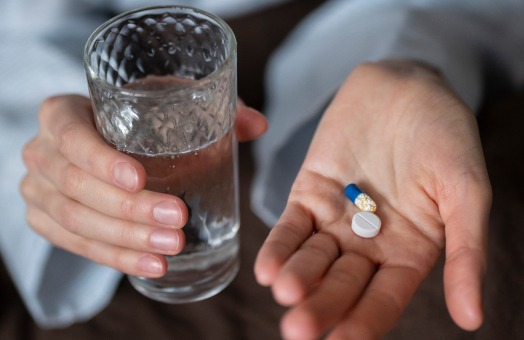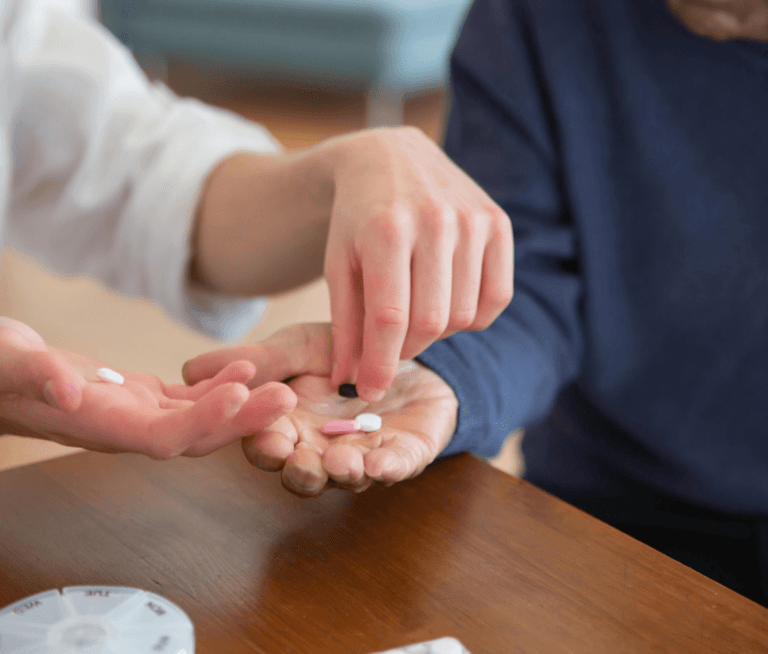Drug withdrawal occurs when a person stops using an addictive substance like cocaine, heroin, alcohol, or another drug. The symptoms of drug withdrawal range from mild to severe and can be life-threatening in some cases. Addiction rehabilitation and treatment services can provide support during this difficult step toward sobriety through medically supervised detoxification, therapeutic support, and prescription medications.
Understanding Drug Withdrawal
Drug withdrawal is one of the trademarks of an addiction to both legal and illegal substances. The specific signs and symptoms of drug withdrawal will vary based on the substance in question. However, symptoms of drug withdrawal typically include (but aren’t limited to) difficulty sleeping, aches and pains, cravings, fatigue, depression, hallucination, nausea, sweating, shaking, irritability, and changing moods,
Supportive medical management can lessen the severity of withdrawal symptoms and help individuals overcome the initial detoxification stage of treatment for Substance Use Disorder.
What Causes Drug Withdrawal?
One of the hallmark signs of drug addiction is a physical reliance on a substance to feel ‘better’ or even ‘normal.’ This is due to the way drugs and alcohol play on the brain’s chemistry, resulting in excess production of neurotransmitters responsible for basic functioning. Over time, the brain relies on the substance to produce these chemicals.
When the substance is no longer present in the body, it results in a severe physiological reaction resulting in withdrawal symptoms. These symptoms can range from mild to completely debilitating when the substance is no longer present in the body.
What is Drug Withdrawal?
Withdrawal refers to the physical and mental symptoms that occur after a person reduces or completely stops using a substance they have developed a physical and/or psychological dependence on. These symptoms may range from mild and short-term to severe, long-lasting, and life-threatening.
The severity of withdrawal symptoms may depend on:
- The type of drug(s)
- The duration of addiction(s)
- The mode of ingestion of drug(s)
- An individual’s age
- Any co-current health conditions
- Current and past mental health disorders
- The approach to the management of withdrawal symptoms
Understanding these symptoms can help you overcome them and help those around you understand how best to support you.
Drug Withdrawal Symptoms
The symptoms of drug withdrawal are dependent on which substances are involved but tend to have a few common symptoms. These may include:
- An inability to control movement, including tremors and shakiness
- Aches and pains in muscles and joints
- Cold sweats, hot flashes, and excessive sweating
- Irritability, aggression, depression, anxiety, and other psychological symptoms
- Nausea, diarrhea, vomiting, and general gastrointestinal upset
- Insomnia
- Paranoia
- Seizures
Can Drug Withdrawal be Deadly?
In some cases, withdrawal from substances like alcohol and benzodiazepines can be life-threatening.[6] In many cases, although withdrawal symptoms can be very severe, individuals can recover and successfully move on to post-detoxification addiction treatment.
Drug Withdrawal as a Sign of Addiction
The presence of withdrawal symptoms is included as one of the criteria required for Substance Use Disorder, according to the Diagnostic and Statistical Manual, Fifth Edition (DSM-5).[1]
Specifically, withdrawal symptoms are those that result from the abrupt reduction or discontinuation of heavy and prolonged substance abuse and are not attributable to another medical condition or mental disorder.
What Does Opiate Withdrawal Feel Like?
Some common withdrawal symptoms that occur with heroin, fentanyl, and other opiate drugs include:[2]
- Yawning
- Watery discharge from eyes and nose
- Stomach cramps, vomiting, diarrhea, and nausea
- Sweating
- Feeling cold
- Pounding heart
- Muscle tension, twitching, and spasms
- General aches and pains
- A feeling of general unwellness
- Difficulty sleeping
What are the Signs of Withdrawal from a Stimulant Drug?
Withdrawing from stimulant drugs like cocaine, crack, amphetamine, methamphetamine, and Adderall often causes both physical and psychological symptoms.[3] These include:
- Increased appetite
- Fatigue and excessive sleeping
- Muscle aches
- Agitation, aggression, and irritability
- Depression
- Suicidal ideation
- Paranoia
- Disordered thoughts
- Hallucinations
Drug Withdrawal Timelines
The detoxification stage of addiction treatment is often the most daunting, but understanding the duration of different types of withdrawal symptoms can help patients and their support teams plan to manage and alleviate these temporary discomforts.
How Long Does It Take to Withdraw From Opiates?
The timeline for withdrawal from an opiate will depend on the type of drug used. Heroin withdrawal typically begins within six to 24 hours after consumption, peaking at 24- 48 hours.[4] Symptoms begin to resolve between four to ten days. Withdrawal from fentanyl may take longer, with intense symptoms beginning around 36 to 72 hours after the last dose and persisting for ten days to several weeks.
What is the Timeline for Stimulant Withdrawal?
Stimulant Withdrawal Syndrome often occurs in three distinct phases— crash, withdrawal, and extinction.[5]
The crash phase of stimulant withdrawal syndrome begins as soon as the stimulant wears off and can last for several days. Symptoms include fatigue, increased sleep, and depression.
Withdrawal symptoms begin between one to four days after the last use of the drug and last for up to 10 weeks. Symptoms may include intense cravings, fluctuating mood and energy levels, agitation, vivid and unpleasant dreams, and other symptoms covered above.
Individuals in recovery enter the extinction phase between 10 and 28 weeks post-use. Some withdrawal symptoms will persist but become lessened and more manageable over time.
Post Acute Withdrawal Syndrome
Post Acute Withdrawal Syndrome (PAWS) refers to symptoms that persist for weeks or months after a person stops using an addictive substance. These impairments may resemble the signs of a mood disorder and include insomnia, mood swings, and anxiety without an external cause. PAWS is quite common, affecting 90% of opiate users and 75% of people recovering from alcohol and psychotropic use.[7]
Types of Drug Withdrawal Treatment
Facing the physical and psychological rigors of drug withdrawal can be daunting. However, it is possible to make it to the other side with the support of loved ones and addiction treatment specialists. Drug withdrawal treatment may include medical detoxification, residential treatment, and therapeutic programs.
-
00 01
Medical Detoxification
Medication and other interventions provided by physicians and nurses, either through inpatient or outpatient programs, lessen and manage withdrawal symptoms.
-
00 02
Residential or ‘Inpatient’ Treatment
Inclusive accommodations offer dietary, medical, therapeutic, and social support in an environment tailored to help individuals avoid substance triggers and merge from withdrawal, ready to enter the next stage of addiction recovery.
-
00 03
Therapeutic Programs
One-on-one counseling begins during withdrawal management and will continue throughout treatment and for as long as a person feels that it’s useful for their lasting sobriety.
-
00 04
Drug Withdrawal Medications Used in MAT Programs
Medication-assisted treatment (MAT) is an important component in both drug withdrawal management and long-term Substance Use Disorder treatment. The type of drug used will depend on the drug in question, along with any underlying mental health disorders.
-
00 05
MAT Drugs Used for Opiate Withdrawal
The Food and Drug Administration (FDA) has approved three drugs for the medically-assisted treatment of opioid dependence:[8] buprenorphine, methadone, and naltrexone. Some commonly approved medications include:
- Buprenorphine Medications:
- Brixadi, an injection for subcutaneous use
- Probuphine, an implant for subdermal administration
- Zubsolv and Subutex, sublingual tablets for oral use
- Methadone Medications:
- Dolophine, a tablet for oral use
- Methadone, a liquid oral medication
- Naltrexone Medication:
- Vivitrol, an extended-release injectable suspension
- Buprenorphine Medications:
-
00 06
MAT Drugs Used for Stimulant Withdrawal
Some research has indicated that a combination of naltrexone plus bupropion may be effective in supporting withdrawal and abstinence from methamphetamine and other stimulants.[9] Some medications prescribed may include:
- Naltrexone Medications:
- Naltrexone, a tablet for oral use
- Vivitrol, an extended-release injectable suspension
- ReVia, a tablet for oral use
- Bupropion Medications:
- Wellbutrin, a tablet for oral use
- Naltrexone Medications:
How Withdrawal Treatment Works
Treatment for drug withdrawal will likely involve a combination of detoxification support, medications, and therapeutic and behavioral treatments.
- Detoxification: Withdrawing is the first step on your journey to sobriety, but it’s also one of the most difficult parts of recovery. Detoxification involves allowing substances to leave your body through supportive interventions designed to lessen the physical and mental discomfort of withdrawal. This may take place in a hospital, clinic, or part of a day program.
- Medication: Medically-assisted treatment (MAT) for Substance Use Disorder is a proven tool against relapse into addiction. Studies indicate that MAT can significantly improve sobriety rates, with many individuals maintaining sobriety beyond the 2-year mark.[10]
- Therapeutic Treatments: One-on-one psychotherapy is designed to help you understand the root causes behind substance abuse, including any other mental health disorders, and to gain a compassionate understanding of yourself as an individual beyond your addiction.
- Behavioral Skills Training: Cognitive Behavioral Therapy (CBT) and Dialectical Behavioral Therapy (DBT) are examples of the behavioral skills training you may be offered. These and other approaches provide skills that allow you to separate your feelings from your behaviors and navigate the complications of daily life more easily moving forward.
What’s the Best Way to Find Withdrawal Treatment?
Starting the journey to beat addiction usually begins with detoxification. To find the resources to be successful in this journey, talk to your doctor or therapist or check out the Substance Abuse and Mental Health Services Administration (SAMHSA) for more options.
Find Withdrawal Treatment Near Me
Facilities that specialize in addiction treatment
Click on a pin to learn more information on a specific facility location
Cost of Drug Withdrawal Treatment
The cost of drug withdrawal treatment depends on several factors, including the type of treatment received, your insurance coverage, and the duration of treatment. To verify your insurance coverage, contact Alpas Wellness.
Frequently Asked Questions
What is post-acute drug withdrawal syndrome?
Post-acute drug withdrawal syndrome (PAWS) refers to prolonged withdrawal symptoms that occur after the acute phase of substance withdrawal. Symptoms can persist for months or years and may include mood swings, sleep disturbances, fatigue, cognitive impairment, and cravings. PAWS is a result of the brain readjusting to functioning without the drug’s presence. Treatment involves counseling, therapy, support groups, and a healthy lifestyle to manage the symptoms effectively.
How can I support someone going through drug withdrawal?
Be understanding and non-judgmental, give them space to talk and be heard, and encourage them to seek support from medical professionals. Remain non-judgemental, and let them know you’re here to help during the process with the tasks of daily life. At the same time, be careful of your emotional limitations and boundaries.
What are MAT Medications?
MAT medications help people recover from addictions to opioids like heroin, fentanyl, and prescription painkillers, and in some cases, support recovery from other Substance Use Disorders.
How can I prevent relapse after drug withdrawal treatment?
Preventing relapse after withdrawal is vital. Build social and professional support networks, attend counseling, and continue to develop strong coping skills. Avoid triggers, educate yourself, and prioritize your well-being for lasting recovery.
Drug
Withdrawal
Resources by Substance
Diagnostic and statistical manual of mental disorders20. DSM Library. (2013). Retrieved on July 28, 2023 from https://dsm.psychiatryonline.org/doi/book/10.1176/appi.books.9780890425596
World Health Organization . (2009). Withdrawal management – clinical guidelines for withdrawal management … Retrieved on July 28, 2023 from https://www.ncbi.nlm.nih.gov/books/NBK310652/
World Health Organization . (2009). Withdrawal management – clinical guidelines for withdrawal management … Retrieved on July 28, 2023 from https://www.ncbi.nlm.nih.gov/books/NBK310652/
Lerner, A., & Klein, M. (2019). Dependence, withdrawal and rebound of CNS drugs: An update and regulatory considerations for New Drugs Development. Brain Communications, 1(1). Retrieved on July 28, 2023 from https://doi.org/10.1093/braincomms/fcz025
Lerner, A., & Klein, M. (2019). Dependence, withdrawal and rebound of CNS drugs: An update and regulatory considerations for New Drugs Development. Brain Communications, 1(1). Retrieved on July 28, 2023 from https://doi.org/10.1093/braincomms/fcz025
Gupta M, Gokarakonda SB, Attia FN. Withdrawal Syndromes. [Updated 2023 Apr 29]. In: StatPearls [Internet]. Treasure Island (FL): StatPearls Publishing; 2023 Jan-. Retrieved on July 28, 2023 from https://www.ncbi.nlm.nih.gov/books/NBK459239/
Ferguson, S. (2022, October 19). How to Recognize and Manage the Symptoms of Post-Acute Withdrawal Syndrome. Healthline. Retrieved from https://www.healthline.com/health/post-acute-withdrawal-symptoms on 2024, June 6.
Center for Drug Evaluation and Research. (2023, May 23). Information about medication-assisted treatment. U.S. Food and Drug Administration. Retrieved on July 30, 2023 from https://www.fda.gov/drugs/information-drug-class/information-about-medication-assisted-treatment-mat
U.S. Department of Health and Human Services. (2021, January 13). Combination treatment for methamphetamine use disorder shows promise in NIH Study. National Institutes of Health. Retrieved on July 30, 2023 from https://www.nih.gov/news-events/news-releases/combination-treatment-methamphetamine-use-disorder-shows-promise-nih-study#
Medications for substance use disorders. (n.d.). SAMHSA. Retrieved from https://www.samhsa.gov/medications-substance-use-disorders on 2024, June 6.






